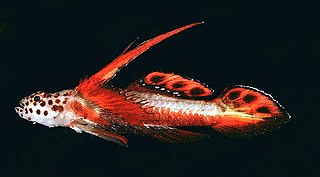
The sand darters, were formerly considered to be a family the Kraemeriidae, but recent research has placed the nine species formerly classified under the Kraemeriidae as belonging to the family Gobiidae, although the researchers do not define the taxonomic status of this grouping within that family. These fish are Indo-Pacific, being native to the Indian Ocean to the central Pacific Ocean. They live in sandy shallow pools and are found among coral. One species is restricted to fresh waters of Madagascar. In breeding coloration the male fish has an occelated spot at the rear of the first dorsal fin. Molecular analyses have placed the Kraemeriidae within the Gobiidae.

Eviota is a genus of fish in the family Gobiidae, commonly as dwarfgobies found in the Indo-Pacific region, where it is distributed from Japan to Australia and from Africa to Pitcairn Island. Species are mainly associated with coral reefs. Many of these fish are short-lived, with life cycles as brief as 3.5 weeks in the tropics. Some species are hermaphrodites and some representatives live symbiotically among the tentacles of the mushroom coral.

The Gobiiformes are an order of fish that includes the gobies and their relatives. The order, which was previously considered a suborder of Perciformes, is made up of about 2,211 species that are divided between seven families. Phylogenetic relationships of the Gobiiformes have been elucidated using molecular data. Gobiiforms are primarily small species that live in marine water, but roughly 10% of these species inhabit fresh water. This order is composed chiefly of benthic or burrowing species; like many other benthic fishes, most gobiiforms do not have a gas bladder or any other means of controlling their buoyancy in water, so they must spend most of their time on or near the bottom. Gobiiformes means "goby-like".

Periophthalmus is a genus of fish in the family Oxudercidae, native to coastal mangrove wood and shrubland in the Indo-Pacific region, except for P. barbarus from the Atlantic coast of Africa. It is one of the genera commonly known as mudskippers. Periophthalmus fishes are remarkable for being able to live, temporarily, in open air where they feed on insects and small invertebrates; out of water they have limited motion abilities, such as jumping. All Periophthalmus species are aggressive and territorial.

True gobies were a subfamily, the Gobiinae, of the goby family Gobiidae, although the 5th edition of the Fishes of the World does not subdivide the Gobiidae into subfamilies. They are found in all oceans and a few rivers and lakes, but most live in warm waters. Altogether, the Gobiinae unite about 1149 described species in 160 genera, and new ones are still being discovered in numbers.
Sueviota is a genus of fish in the family Gobiidae native to the Indian and Pacific Ocean.
Helen K. Larson is an ichthyologist who specialises in the fishes of the Indo-Pacific.
Ernest Albert Lachner was an American ichthyologist with an international reputation for his research on Indo-Pacific gobies and cardinalfishes.

Oxyurichthys notonema, commonly known as the threadfin mudgoby, is a species of goby endemic to the Indo-West Pacific. This species reaches a length of 7.5 cm (3.0 in).

Oxyurichthys tentacularis is a species of goby found in the Indo-West Pacific from the Transkei northwards, Zanzibar, and Madagascar to the tropical West Pacific. This species reaches a length of 17.0 cm (6.7 in).
Oligolepis formosanus is a species of goby found in the Indo-West Pacific. This species reaches a length of 5 cm (2.0 in).

Discordipinna griessingeri is a small, brightly colored, marine neritic fish in the family Gobiidae that is commonly called the spikefin goby or flaming prawn goby. Occasionally it is mislabeled as "Stonogobiops griessingeri" which is a binomial species name that does not formally exist. The spikefin goby has a wide distribution across reefs throughout the western tropical Pacific, Pacific Islands such as Hawai'i or Polynesia, the Indian Ocean, and the Red Sea. It is also occasionally collected and traded as an exotic aquarium fish in multiple countries.
Sueviota bryozophila the bryozoan goby, is a species of fish in the family Gobiidae. It is found in Indonesia.
Sueviota tubicola, the tubeworm dwarfgoby, is a species of fish in the family Gobiidae. It is found in Papua New Guinea.

Sueviota aprica, the sunny dwarfgoby, is a species of fish in the family Gobiidae. found in Indonesia.This species reaches a length of 1.4 cm (0.55 in).
Sueviota lachneri, also known as Lachner's dwarfgoby, is a species of fish in the family Gobiidae. found in the Maldives.
Sueviota larsonae, also known as Larson's sueviota, is a species of fish in the family Gobiidae. It is found in the western-central Pacific Ocean.
Sueviota pyrios, the fiery dwarfgoby, is a species of fish in the family Gobiidae..
Gobiopsis woodsi, also known as Woods' barbelgoby, is a species of goby found in the Indo-west Pacific.

Oxuderces dentatus, is a species of goby found in the Indo-West Pacific from India to Vietnam, Macau, China, Malaysia and Indonesia.









